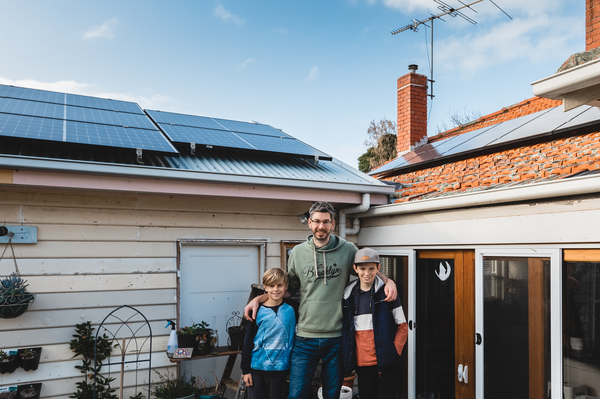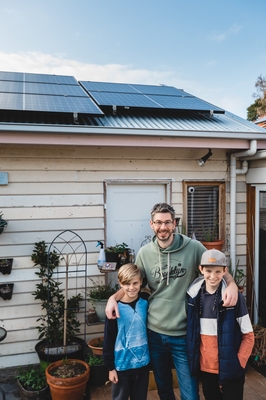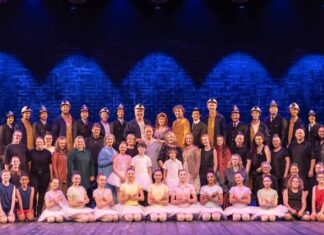With more locals than ever installing solar panels, Geelong Sustainability is calling for an upgrade to the “struggling” grid. Luke Voogt speaks to some of the Geelong families hoping to lessen their impact on the environment.
When Simon and Kaylene Reeves bought their first home in Norlane, they saw a chance to help make a better world for their three children.
“It had always been our dream to have our home as sustainable as possible,” Mr Reeves told the Independent.
“We’ve pretty much rented our whole lives. Three or four years ago, we were finally able to purchase our own home.”
In mid-2018, the family installed a solar system through a program run by Geelong Sustainability.
Mr Reeves said he was quite concerned “for the future of our planet and what we’re doing to it”.
“From what I can tell it’s a very bleak future for our young people.”
The couple wanted their children Barwon, 10, Jarrah, 8, and Eden, 5, to inherit a better world, he said.
“The next ten years are really critical for us to get the way we live on this planet right.
“We want our children to grow up and enjoy their lives and not have to endure the consequences that our generation and generations before us have unleashed.
“My wife and I are aware of our impact on the planet in terms of our carbon footprint.
“I know we can’t do everything but we can at least do our bit to lessen our impact. Solar panels were a big part of that plan.”
While the decision was not financially motivated, the family was saving hundreds of dollars in bills, Mr Reeves said.
“When the sun went down our [5.7 kilowatt] battery would kick in and get us through the night.
“We’d wake up in the morning and we wouldn’t have used a kilowatt [from the grid]. We went into credit because we were generating more power than we could use.”
Credits from during summer had helped the family save in winter too, Mr Reeves said.
The system had also helped them educate their kids, he said.
“It doesn’t stop me chasing after them turning the lights off.”
Harrison and Zena Lengelsen-Brown, who moved to Clifton Springs a month ago for a “sea change” and to “get more bang for their buck”, share the dream of a better world.
“We want to be part of the solution to our fossil fuel addiction,” Mr Lengelsen-Brown said.
“There’s so [many solar options] out there, I’ve discovered. I think I’ve got six or seven quotes from different organisations.”
The first-home buyers moved with their 18-month-old son to the Bellarine Peninsula to afford “a little house rather than a two-bedroom apartment” in Melbourne, Mr Lengelsen-Brown said.
But a limit on the electricity they could sell back to the grid, due to a lack of infrastructure, had prevented them from installing solar so far, he said.
A local solar installer informed them they could only feed 1.7 kilowatts into the grid, he explained.
“Generally, you want to feed about five kilowatts in, that’s what makes it financially viable.”
Selling electricity into the grid during the day helped offset the costs of peak-hour usage, Mr Lengelsen-Brown explained.
“Obviously, we tend to use energy during the evening, so you need to buy back from the grid,” he said.
“We’re not going to be selling back much at all.”
A battery could make the system more financially-viable but would cost the couple $10,000 extra up-front, Mr Lengelsen-Brown said.
“We’re first home buyers, so we have a limited budget.”
Mr Lengelsen-Brown’s situation is becoming increasingly common as the grid struggles to cope with the number of people installing solar, according to Geelong Sustainability’s Vicki Perrett.
“Geelong Sustainability is very concerned about the current network limitations, which prevent people from connecting their rooftop solar systems to the grid,” she said.
“Homeowners who want to take control of their power bills are being denied the option to export excess power.
“[This] leaves them with two unsatisfactory options – doing nothing or going off grid – neither of which … are fair or desirable.”
About 18 per cent of buildings in Geelong have solar installed, according to data from Australia’s Clean Energy Regulator.
Given Victoria’s renewable energy target of 50 per cent renewables by 2030, Geelong needed “three times as many people connecting” amid a climate “emergency”, Ms Perrett said.
Geelong was also lagging behind the neighbouring municipalities of the Surf Coast Shire, Borough of Queenscliffe and Golden Plains Shire in solar installation, she said.
With solar being installed “faster than ever” Powercor is proposing to spend $61 million over the next five years to upgrade the grid.
But Geelong Sustainability says the upgrade is needed now.
Geelong experienced an almost 15 per cent increase in solar installations from 2018 to 2019 in grids operated by Powercor.
The postcode of 3217, including the growth areas of Armstrong Creek, Mount Duneed and Charlemont led the charge with an increase of 60 per cent.
More affluent suburbs of Geelong generally had higher levels of uptake according to the data.
Powercor proposed an upgrade to the Australian Energy Regulator that would allow households to export up to five kilowatts into the grid, according to its electricity networks general manger Steven Neave.
“We want to support customers to make this choice by making strategic investments to allow the network to keep pace,” Mr Neave said.
Information on Powercors’ proposal: www.talkingelectricity.com.au.









